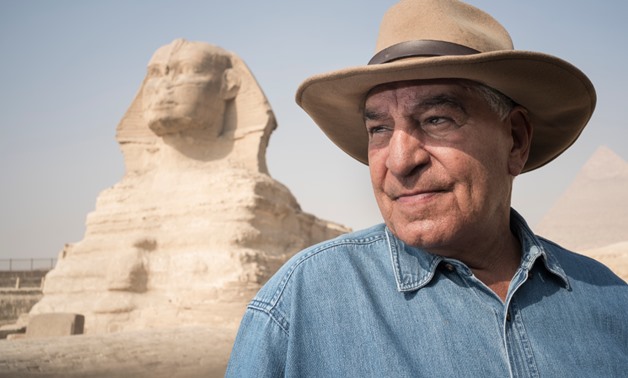
Hawass - ET
CAIRO - 26 April 2020: Archaeologist Zahi Hawass said there is no reason for Sheikh Ali Gomaa, the former Grand Mufti of Egypt, to talk about archeology.
Hawass said Gomaa is a “man of religion”, and so when he spoke about archaeology, he did not back his claim up by relevant scientific evidence, but rather used information reported by obsessed archaeology fanatics.
Hawass further explained that Sheikh Ali Gomaa mostly repeated what Sayed Karim claimed in his book "The Mystery of Egyptian Civilization", and that the book is full of fantasies that are far from science. The veteran archeologist also claimed that Gomaa repeated what Mostafa Mahmoud said in his famed program “Science and Faith".
According to the Egyptian archaeologist, this resembles the incident when some fame-seekers claimed the Pyramids of Giza were built by people who came from the lost continent of Atlantis.
“What is his evidence that Prophet Idriss was the first to build the pyramids and that the statue of the Great Sphinx is an embodiment of him?!” Hawass asked.
“First, we have full evidence that King Djoser built the first pyramid we have. Imhotep was the first to switch from using mud-bricks to stones. We have the oldest papyrus found to date, the Wadi al-Jarf papyrus, in which the chief of staff, Murar, talks about building the pyramid of Khufu,” said Hawass.
Hawass stated that the pyramid area was initially called "Ankh Khufu", meaning “Khufu lives”, and that Khufu lived in a palace inside the pyramid. Afterwards, building the pyramids continued until the beginning of the modern state.
Also, the veteran archaeologist stressed that we cannot deny evidence from the royal tombs in Giza, where information about the priests of Khufu, Khafre and Menkaure is clearly illustrated. "Is it possible to forget the royal lists that specify the names of Egyptian kings that did not include the name of Prophet Idris, peace be upon him?"
As for the Sphinx, it does not go back to the era of Khufu and Khafre, like Sheikh Ali Gomaa mentioned. “This is a fatal mistake!” explained Hawass.
According to Hawass, scientific evidence indicates that the Sphinx dates back to the era of King Khafre. It was sculptured in a way depicting him in the form of Horus, as he worshiped the deity Ra.
The ancient Egyptians had linked the power of the lion to the power of the king, depicting the king as a lion stepping on and trampling the enemies. This art form has appeared in the era of King Djedefre, the son of King Khufu, showing the king with a human face and a lion's body.
This depiction of the kings continued in the fifth and sixth dynasties until the end of the late era on the Sphinx road that links the Luxor Temple to the Karnak temples.
“I have no idea how Sheikh Ali Gomaa linked the Sphinx to prophet Idriss? What is your evidence, Sheikh Ali?” asked Hawass.
"As for the claim that prophet Idriss was the first to call for monotheism, we should not forget that before there were any heavenly religions, King Akhenaten was the first person to talk about monotheism," clarified the veteran Egyptian archaeologist.
Furthermore, Hawass clarified that Idriss was linked to Osiris because of linguistic similarity between the two names only.
“I am very sorry to say that Dr. Sayed Karim repeated all this without knowledge or evidence, and that Prophet Idriss did not teach mummification, because mummification did not just suddenly appear; the Egyptians kept developing it from the First Dynasty when they dried the bodies, and added some material to the legs. In the Fourth Dynasty, the work of masks was developed, and embalming did not reach its peak until the 18th Dynasty,” said Hawass.
“At the end, I must say that I respect and appreciate Sheikh Gomaa on the personal level, but when he speaks about archaeology without knowledge or evidence, I have to stop him. Stop repeating what non-specialists are saying without evidence,” concluded Hawass.

Comments
Leave a Comment